We spoke with water safety experts to learn what contaminants might be lurking in our tap water, how to test it, and if fluoride is safe.

Is Tap Water Safe to Drink: Experts Explain What You Should Know About Your Home’s Water Supply

About the experts
|
Highlights
|
We might take it for granted when we grab water from the faucet without questioning if the tap water is safe to drink. Because for about 4.4 billion people—more than half the world’s population—it isn’t, according to a 2024 study published in Science.
Fortunately, “in most parts of the U.S., tap water is safe to drink,” explains Rianna Murray, PhD, MPH, an Assistant Research Professor at the University of Maryland and lead investigator on the Maryland Safe Drinking WATER Study. But safety concerns do linger among experts.
Below, water quality specialists explain what you should know about the tap water in your home—and how to ensure it’s safe to drink.

Where does tap water come from?
“Tap water typically comes from surface water—lakes, rivers, and reservoirs—or underground aquifers accessed by public utilities,” Dr. Murray explains. “Once collected, this water is processed at water treatment facilities that remove sediments, remove pathogens, and adjust chemical balances to meet public health standards set forth in the Safe Drinking Water Act.”
After the water is treated and deemed safe, it is sent through distribution systems to our homes, she says. This process is regulated by the Environmental Protection Agency (EPA).
Beyond these community water systems, about 15% of Americans get their drinking water from private wells, says Erik Modlo, MD, MBA, IFMCP, a Functional Medicine Physician at Cleveland Clinic. “Unlike municipal systems, these wells aren’t regulated by the EPA, so it’s important that homeowners test their well water frequently to make sure it’s safe.”
The EPA recommends that well owners test their water at least once per year for total coliform bacteria, nitrates, total dissolved solids, and pH levels, Dr. Murray says.
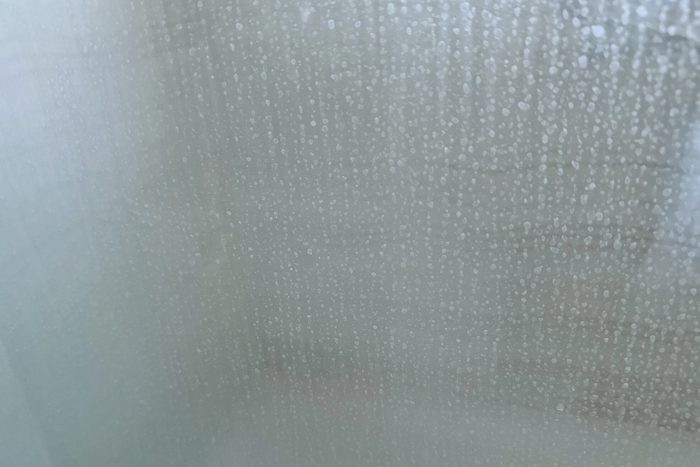
What’s the difference between hard and soft water?
The EPA doesn’t regulate “water hardness,” the U.S. Geological Survey notes—though some utility companies may manage it voluntarily. Hard water means that there are higher levels of minerals like calcium and magnesium dissolved in a household’s tap water, generally because an area’s local water source is rich in these minerals.
Hard water isn’t considered harmful (and the minerals may actually contribute to your overall nutrient intake), but it can be annoying. The mineral content can cause buildup in your pipes and appliances and on your shower walls and can leave residue on glassware. Hard water can also be cause dry skin.

Is tap water safe to drink?
Tap water in the U.S. is generally safe to drink, Dr. Modlo says. “The EPA regulates the safety of tap water under the Safe Drinking Water Act, which establishes standards for about 90 contaminants.”
In addition, public water systems are required to regularly monitor quality and report any violations, explains Dr. Murray. Consumers then receive an annual water quality report called a Consumer Confidence Report (CCR).
“However, keep in mind that not all contaminants are regulated,” says Sydney Evans, MPH, a Senior Science Analyst and drinking water contaminant specialist with the Environmental Working Group (EWG). She adds that in some cases, the legal limits of certain contaminants set by the EPA are higher than levels deemed safe by the latest health research.
Safety can vary at the local level as well. “Infrastructure problems—such as aging pipes—can compromise water quality, leading to issues such as the lead in the drinking water crisis that occurred in Flint, Michigan,” says Dr. Murray. The source water quality, local industrial or agricultural practices, and the state of the water treatment and distribution systems can also influence the quality of an area’s tap water, Evans explains.
In general, Dr. Modlo says that the main things that can affect your household tap water safety include:
- Age and condition of plumbing: Homes built before 1986 may still have lead pipes or lead solder that can leach harmful substances into the water, according to the EPA.
- Regional variations: Some places have natural contaminants in their groundwater, while places with smaller water systems may not be able to treat the water as effectively.
- Burning: Industrial processes often burn fossil fuels, resulting in the emission of new pollutants.
- Agricultural runoff: In rural areas, runoff from farms coated with pesticides and fertilizers may taint nearby water supplies.
- Municipal water treatment: Water treatment system efficacy can also change—some systems have aging facilities or just lack the resources.

Potential changes to U.S. tap water quality you should know about
“The Trump administration and EPA administrator Lee Zeldin are considering rolling back the most important progress that’s been made on drinking water standards in a generation—the Maximum Contaminant Limit (MCL) for the “forever chemicals” known as PFAS,” says Melanie Benesh, JD, the Vice President of Government Affairs at the EWG.
She explains that in 2024, the EPA passed its first-ever national drinking water standards for PFAS, setting maximum limits that public water systems are required to monitor and comply with. “These chemicals have been linked to cancer, reproductive harm, immune system damage, and other serious health problems, even at low levels,” Benesh says. “Rolling back these protections could expose millions across the U.S. to higher levels of these chemicals.”
In addition to targeting the PFAS MCL, she says that legislators have recently proposed reversing the 2024 ban on trichloroethylene, or TCE, which has been linked to serious health harms even at low levels of exposure. “TCE already contaminates the drinking water of over 17 million, and reversing this ban gives the green light for polluters to use this dangerous chemical and could lead to environmental contamination in the future.”
What’s more: “Newer chemicals and toxins from algal blooms and other globalized pollutants have recently emerged,” Dr. Modlo says. “To improve water quality, these sources must be addressed alongside the dynamics that enable the persistence of contaminants.”
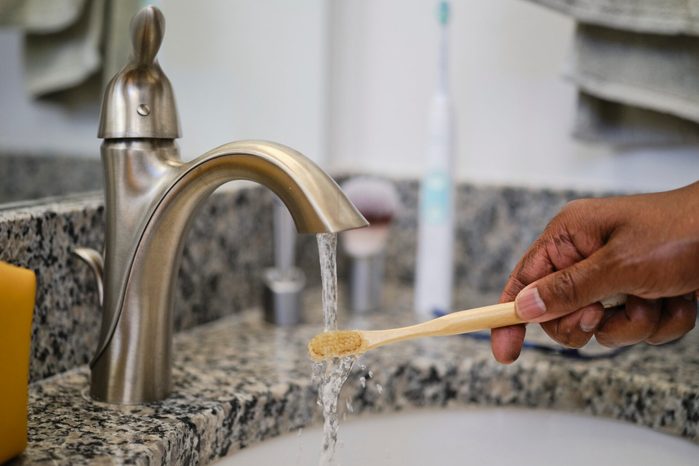
Why is there fluoride in tap water and is it safe?
Fluoride is added to many municipal water supplies as a public health measure to help prevent tooth decay, Dr. Murray explains. “The practice has been done for over 75 years and is endorsed by the CDC, the World Health Organization (WHO), and the American Dental Association, among others, as being safe and effective against cavities,” she says. The current recommended level (0.7 mg/L) has been carefully determined to balance benefits and safety.
“Despite widespread support from the scientific community and health officials, many myths persist about the safety of fluoride,” she says. “Claims linking fluoride to cancer, lowered IQ, or other health problems have been debunked by scientific studies.”
While the current Secretary of Health and Human Services is calling for a ban on fluoridated water—and Utah has already removed it from its public water sources—“peer-reviewed studies consistently show that water fluoridation reduces tooth decay across populations without posing harm at recommended levels,” she explains.
In fact, Juneau, Alaska discontinued tap water fluoridation in 2007, and a follow-up study in 2018 published in BMC Oral Health measured the impacts. The researchers found that every age group in the area experienced higher levels of cavities—especially children born after the fluoride removal. The study also found that, on average, dental costs for children increased by about $300 per year per child.
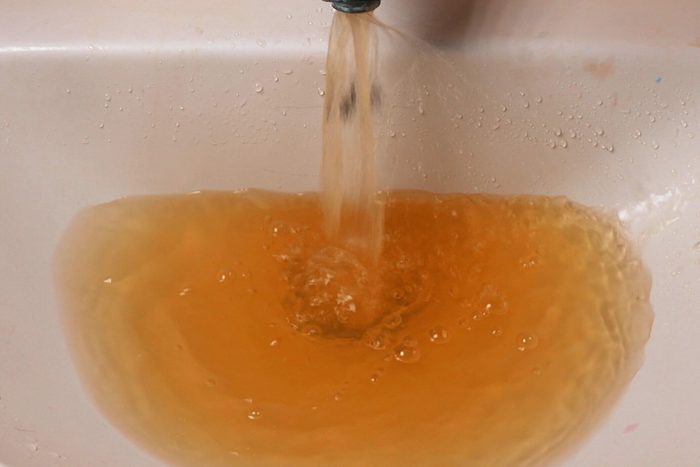
Chemicals that could potentially contaminate tap water
“Sources of contaminated water include natural mineral deposits, industrial pollution, agricultural runoff, old pipelines, and the limits of water treatment,” Dr. Modlo says. Common contaminants are bacteria, viruses, chemicals—such as lead and pesticides—and residue from medications.
Specifically, Dr. Murray says that possible tap water chemical contaminants can include:
- Heavy metals like lead and copper, usually from aging plumbing fixtures or service lines.
- Nitrates from fertilizers and agricultural runoff.
- PFAS, “forever chemicals” used in a whole host of products, such as fast food wrappers, takeout containers, nonstick pans, water-repellent clothing, cleaning products, paints, firefighting foam, and more.
- Volatile organic compounds (VOCs) from industrial waste or fuel.
- Pesticides and herbicides leaching into surface or groundwater.
- Industrial waste from spills or improper disposal.
But this is far from a comprehensive list, she explains.
“EWG’s Tap Water Database has compiled millions of records from tens of thousands of systems across the United States, revealing that over 300 contaminants have been detected in U.S. water systems,” Evans says—even arsenic, a potent carcinogen.
“These contaminants can enter water supplies through infrastructure corrosion, runoff from farms or urban areas, heavy rains, seepage from landfills, or industrial discharges,” says Dr. Murray.
And, as Dr. Modlo addressed, water treatment has its own limitations and complications, too.
“Although disinfection is critical for removing pathogens, disinfectants can interact with chemical contaminants and organic matter in the water to form disinfection byproducts,” Evans explains. “These byproducts can pose their own health risks.”
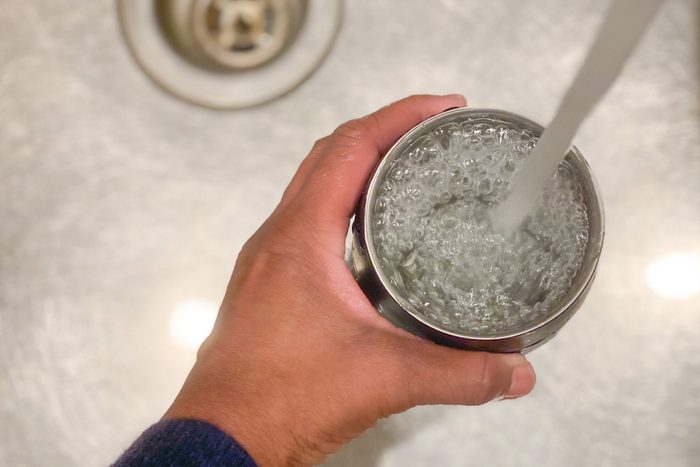
Could tap water cause any health issues?
“While the majority of public tap water is safe, some contaminants can cause health issues with chronic exposure, even at low levels,” Dr. Murray says.
According to Dr. Murray and Dr. Modlo, the top offenders include:
- Lead: Lead is a neurotoxin that’s especially dangerous for children and pregnant women—it can affect brain development and cause learning issues.
- Other chemical contaminants: Lead, arsenic, and industrial pollutants may lead to the development of chronic conditions such as kidney and liver damage, Dr. Modlo says.
- Nitrates: Consuming nitrates can be risky for babies, says Dr. Murray, possibly leading to “blue baby syndrome,” which affects oxygen levels in the blood.
- PFAS: “Long-term exposure to PFAS may increase cancer risk or affect hormone and immune systems,” Dr. Murray says.
- Biological contaminants: A common bacteria called Cryptosporidium can cause severe gastrointestinal illness, particularly in vulnerable populations.
Dr. Modlo explains that certain groups of people are particularly vulnerable to these health impacts from contaminated water, including:
- Babies
- Young kids
- Pregnant women
- Older adults
- Those with compromised immune systems (from medication or other existing health conditions, such as diabetes)
“Immunocompromised individuals may not be able to fend off waterborne pathogens that healthy people could, and children are especially vulnerable to developmental consequences from any lead and other contaminants,” Dr. Modlo says.
He says that anyone who’s immunocompromised should not drink untreated water from natural sources, not swallow water during recreational activities, and consider using specialized filtration systems capable of removing pathogens and pharmaceutical contaminants.

How to learn more about the quality of your tap water
So, how do you know if there are potentially harmful chemicals in your home’s tap water?
“Most contaminants in tap water are present in concentrations so low that they can’t be detected by color, taste, or smell,” Evans explains. “The best way to ensure water safety is to rely on testing data.”
Public utilities are required to issue an annual Consumer Confidence Report that details the findings of their testing. This water report outlines detected contaminants and whether they meet regulatory standards, Dr. Murray explains. The EPA says that your local water supplier must send your area’s CCR water report by July 1 each year. But you can also find it anytime using the EPA’s CCR search tool.
You can also check the EWG’s Tap Water Database for your area. This report includes data from the CCR but also highlights contaminants that are not currently regulated by the EPA. It also uses stricter standards for contamination based on potential health risks.
However, these reports provide data for the broad local public water supply. If you’re concerned about potential contaminants in your home tap water—like if you live in a building with old plumbing or use well water—you can test your water with a home test kit, Dr. Modlo says.
While there are many DIY water testing kits, the results can be hard to read and may lack accuracy (unless you’re testing for something specific, like lead). Kits that have you send off samples often provide broader testing and greater accuracy.
For example, Tap Score is a highly rated home water test kit that has you send a sample to a local lab certified by multiple compliance agencies, including the EPA. These labs can test for over 100 different contaminants, including heavy metals, bacteria, nitrates, VOCs, PFAS, water treatment byproducts, and more—and the report you get back contains actionable advice to improve your home water quality.
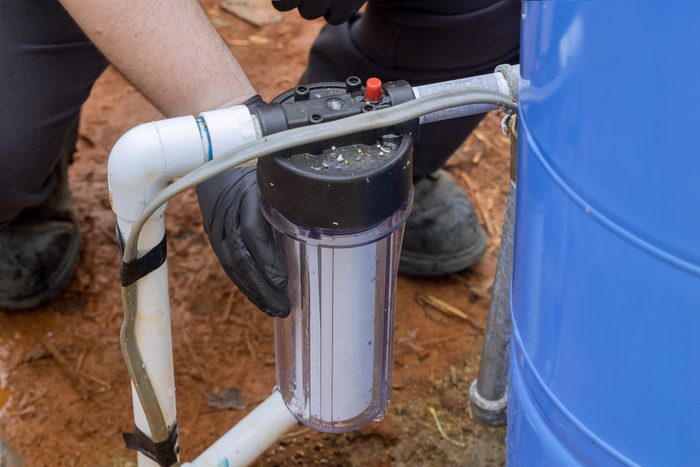
Should you get a water filter?
“For those who wish to add an extra layer of protection, installing a water filter can be a practical solution,” Evans says. But not all filters are created equal. “It’s important to choose a filter specifically designed to address the contaminants present in your water.” (Here’s a guide that breaks down the most common types of water filters.)
For instance, activated carbon filters can be used for chlorine, while reverse osmosis systems are more suitable for heavy metals, Dr. Modlo explains.
You also want to make sure any filter you buy is certified by the National Sanitation Foundation (NSF) to remove the specific contaminants you’re concerned about—like lead, PFAS, or chlorine byproducts, Dr. Murray adds.
“It has been noted that appropriate water filtration systems that meet local water quality reports are advised to minimize exposure—but susceptible populations [like immunocompromised individuals] should follow more stringent guidelines,” Dr. Modlo adds.
As for water filter straws, such as LifeStraw, most are certified to filter out parasites, bacteria, microplastics, and, in some cases, chlorine. So while it can be a good tool to avoid a waterborne stomach bug while traveling or camping, filter straws aren’t capable of removing contaminants like PFAS, heavy metals, or other chemicals.
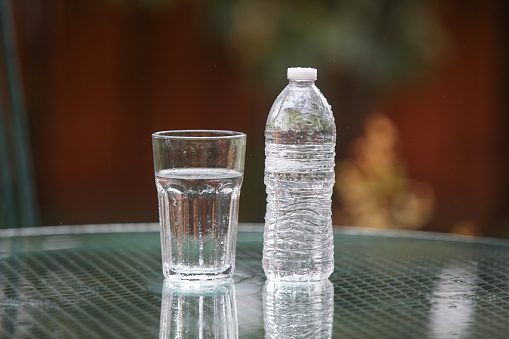
Is it safer to drink tap water or bottled water?
Drinking tap water is generally safe in the U.S. While contaminants can get into your tap water supply, health effects depend on the contaminant, concentration, and duration of exposure, Dr. Modlo says.
If you’re proactively keeping tabs on and maintaining your home’s water quality (more on that below), tap water is safe to drink. In fact, it might be safer than bottled water.
This is because bottled water is not regulated by the EPA, and so it doesn’t have to comply with the Safe Drinking Water Act. It does have to meet standards set by the U.S. Food & Drug Administration (FDA), but according to 2024 research published in BMJ Global Health, tap water faces stricter regulations than bottled water—and bottled water manufacturers don’t have to meet the same disclosure or quality standard requirements that the EPA enforces.
Additionally, a 2023 study published in Environmental International tested 30 types of bottled water and found almost 100 types of contaminants, including arsenic, lead, uranium, nitrates, and VOCs. Microplastics in bottled water are another concern, according to the National Institutes of Health (NIH). In a 2024 study published in Proceedings of the National Academy of Sciences (PNAS), researchers found that an average liter of bottled water contained about 240,000 tiny pieces of plastic.
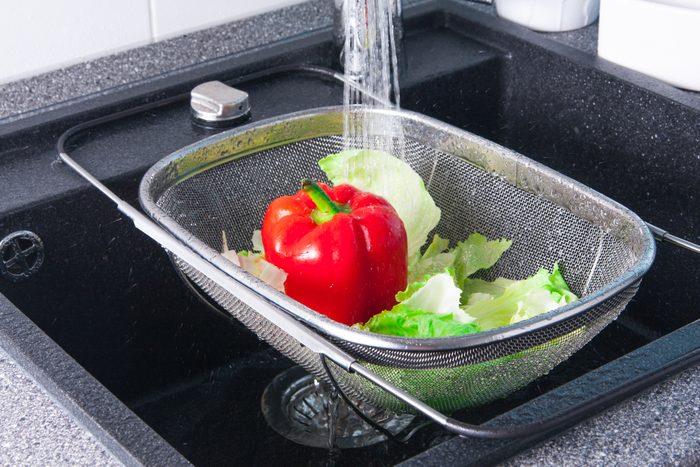
Is it safe to use tap water when cooking?
Tap water that’s safe to drink is safe for cooking. “However, there are instances when caution may be needed,” Dr. Modlo says. “If there are known water quality problems where you live—including lead contamination from old pipes—you may need to use filtered water for drinking and cooking.”
Likewise, if your local water authority has released a boil water advisory because of a contamination, make sure to follow those recommendations. “[These] may involve boiling water for more than one minute to disinfect it,” he explains.
Another pro tip: “Use cold water for drinking and cooking since hot water is more likely to leach metals from pipes,” Dr. Murray says.

Should you be concerned about showering?
If you see gunky white or yellow buildup on your shower head, don’t panic. This just means that you have hard water in your area, which causes mineral deposits (also known as limescale). A 30-minute vinegar soak and a bit of scrubbing usually solves the problem—and you could also consider installing a water softener that works to reduce your tap water’s mineral content.
“In most developed countries with regulated water systems, tap water is safe for cooking, showering, and brushing teeth,” Dr. Modlo explains. “Municipal supplies are usually treated with disinfectants such as chlorine to kill bad bacteria and pathogens, and have periodic testing to ascertain they meet safety standards.”
However, if someone has a compromised immune system, he says that brushing teeth with filtered water may offer added protection.
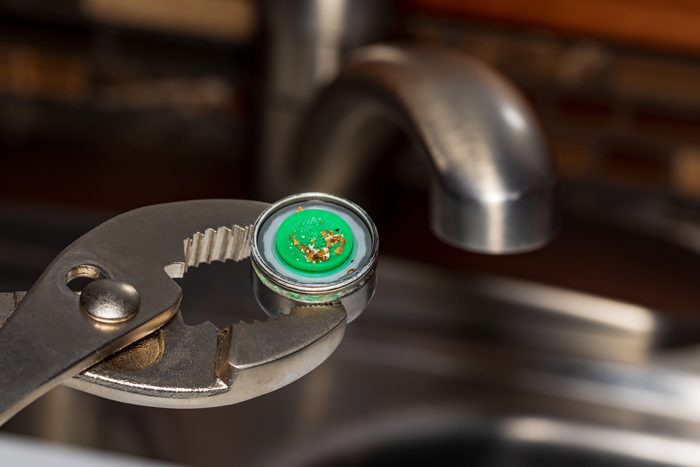
Ways to ensure your tap water is safe
The easiest way to see if your tap water is safe to drink is to check your local water report, Dr. Murray says. “Your annual CCR outlines detected contaminants and whether they meet regulatory standards.”
Still, our experts offer more tips to help ensure and maintain healthy tap water at home:
- Test your water: Especially if you use a private well or live in an older home that might have lead pipes.
- Use a water filter: Choose one that’s certified by the National Sanitation Foundation.
- Maintain plumbing: Replace old lead pipes and repair leaks as soon as they occur.
- Clean aerators on taps at least once a month.
- Flush your taps: “If water has been stagnant for over 8 hours, letting it run for 30 seconds to 2 minutes before using the water can reduce lead and copper exposure,” Dr. Murray says.
- Follow water advisories: In emergencies or during water boil advisories, carefully follow official instructions. After advisories are lifted, run your faucets on full blast for more than five minutes to flush the lines, Dr. Modlo says.
“Periodic maintenance is also key,” Dr. Modlo adds. “You can periodically increase the hot water temperature above 150°F at the point of use or use appropriate chlorination techniques to decontaminate your system when fewer people are home.”
And while tap water contaminants aren’t usually detectable, Evans says, “If your tap water ever does have a noticeable color, smell, or taste, it’s a good sign that further investigation and testing are warranted.”
For daily wellness updates, subscribe to The Healthy by Reader’s Digest newsletter and follow The Healthy on Facebook and Instagram. Keep reading:



















